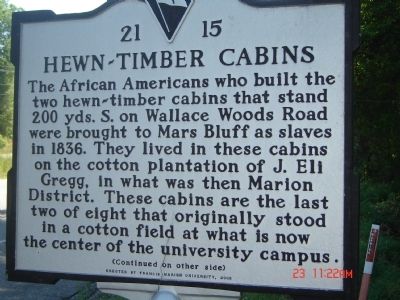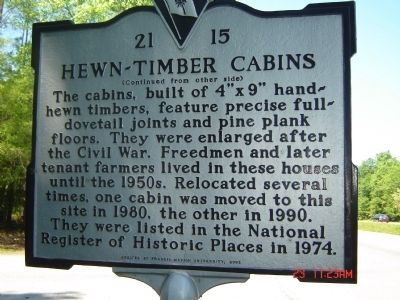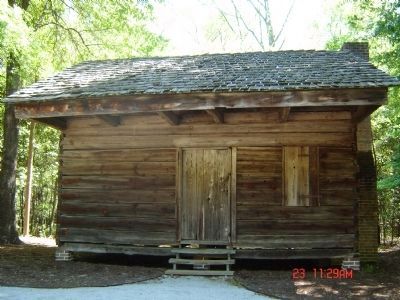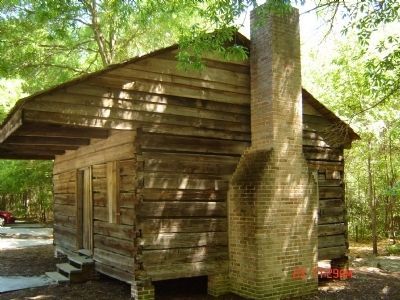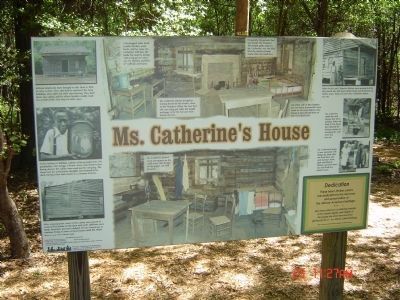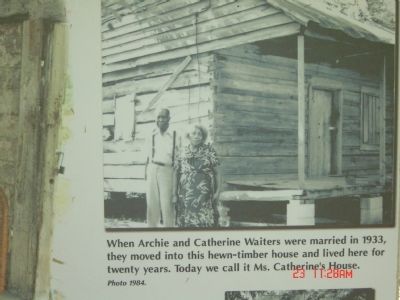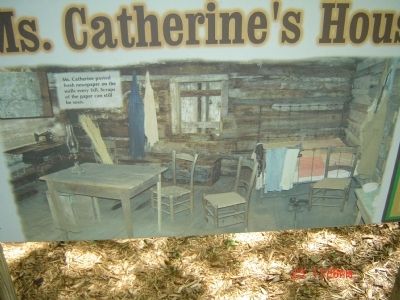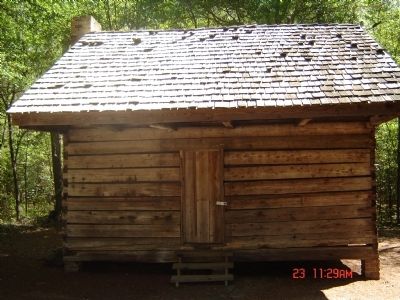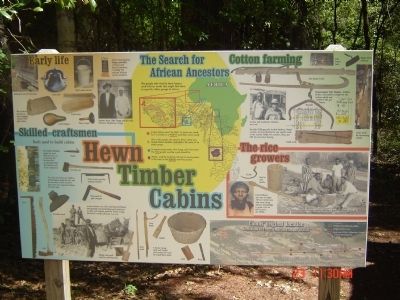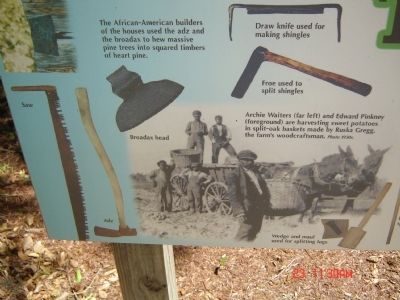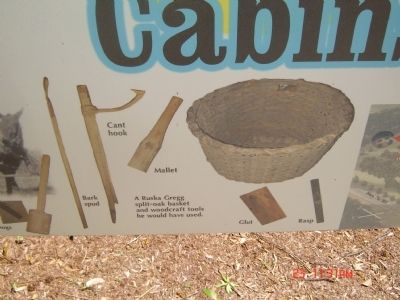Near Florence in Florence County, South Carolina — The American South (South Atlantic)
Hewn-Timber Cabins
(Continued on other side)
(Continued from other side)
The cabins, built of 4"x9" hand-hewn timbers, feature precise full-dovetail joints and pine plank floors. They were enlarged after the Civil War. Freedmen and later tenant farmers lived in these houses until the 1950s. Relocated several times, one cabin was moved to this site in 1980, the other in 1990. They were listed in the National Register of Historic Places in 1974.
Erected 2002 by Francis Marion University. (Marker Number 21-15.)
Topics. This historical marker is listed in this topic list: African Americans. A significant historical year for this entry is 1836.
Location. 34° 11.754′ N, 79° 38.993′ W. Marker is near Florence, South Carolina, in Florence County. Marker is at the intersection of State Highway 76 and Wallace Woods Road, on the right when traveling east on State Highway 76. Touch for map. Marker is in this post office area: Florence SC 29506, United States of America. Touch for directions.
Other nearby markers. At least 8 other markers are within 2 miles of this marker, measured as the crow flies. Francis Marion Memorial Highway (about 400 feet away, measured in a direct line); Gregg-Wallace Farm Tenant House (approx. 0.4 miles away); Mars Bluff Rice Growers (approx. 0.7 miles away); Mars Bluff (approx. 0.7 miles away); Atomic Bomb Accident at Mars Bluff, March 11, 1958 (approx. ¾ mile away); Mt. Zion Rosenwald School (approx. 1.2 miles away); Mt. Zion Methodist Church (approx. 1.2 miles away); Red Doe (approx. 1.4 miles away). Touch for a list and map of all markers in Florence.
More about this marker. Marker and cabins are on the campus of Francis Marion University.
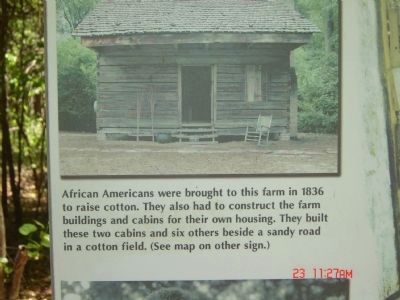
Photographed By Michael Sean Nix, April 23, 2009
6. Part of Ms. Catherine's House sign
African Americans were brought to this farm in 1836 to raise cotton. They also had to construct the farm buildings and cabins for their own housing. They built these two cabins and six others beside a sandy road in a cotton field.
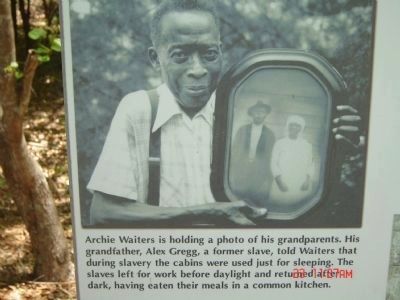
Photographed By Michael Sean Nix, April 23, 2009
7. Part of Ms. Catherine's House sign
Archie Waiters is holding a photo of his grandparents. His grandfather, Alex Gregg, a former slave, told Waiters that during slavery the cabins were used just for sleeping. The slaves left for work before daylight and returned after dark, having eaten their meals in a common kitchen.
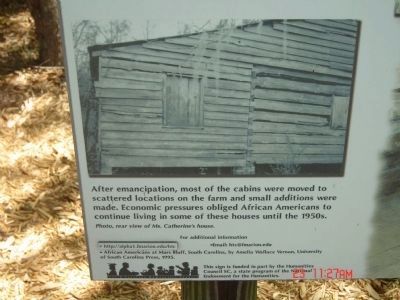
Photographed By Michael Sean Nix, April 23, 2009
8. Part of Ms. Catherine's House sign
After emancipation, most of the cabins were moved to scattered locations on the farm and small additions were made. Economic pressures obliged African Americans to continue living in some of these houses until the 1950s.
Photo, rear view of Ms. Catherine's house.
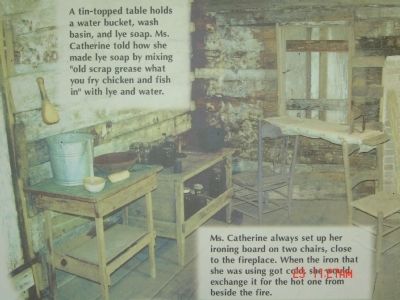
Photographed By Michael Sean Nix, April 23, 2009
9. Part of Ms. Catherine's House sign
A tin-topped table holds a water bucket, wash basin, and lye soap. Ms. Catherine told how she made lye soap by mixing "old scrap grease what you fry chicken and fish in" with lye and water.
Ms. Catherine always set up her ironing board on two chairs, close to the fireplace. When the iron that she was using got cold, she would exchange it for the hot one from beside the fire.
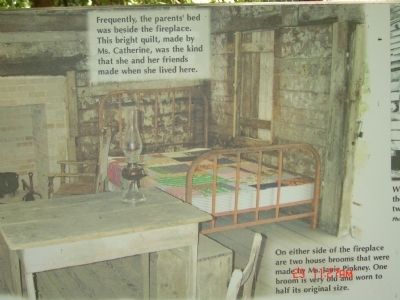
Photographed By Michael Sean Nix, April 23, 2009
10. Ms. Catherine's House Information Sign
Frequently, the parent's bed was beside the fireplace. This bright quilt, made by Ms. Catherine, was the kind that she and her friends made when she lived here.
On either side of the fireplace are two house brooms that were made by Ms. Janie Pinkney. One broom is very old and worn to half its original size.
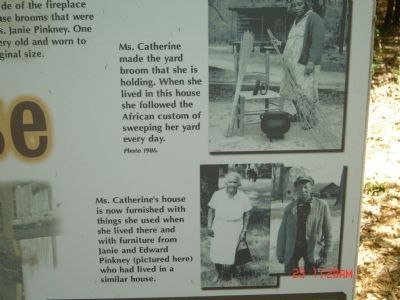
Photographed By Michael Sean Nix, April 23, 2009
12. Ms. Catherine's House Information Sign
Ms. Catherine made the yard broom that she is holding. When she lived in this house she followed the African custom of sweeping her yard every day.
Ms. Catherine's house is now furnished with things she used when she lived there and with furniture from Janie and Edward Pinkney (pictured here) who had lived in a similar house.
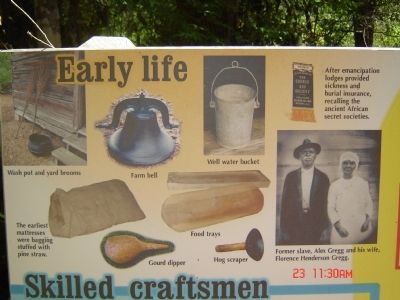
Photographed By Michael Sean Nix, April 23, 2009
16. Hewn-Timber Cabins Information Sign
Sign includes examples of wash pot, yard broom, farm bell, well water bucket, gourd dipper, food trays, hog scraper, mattress made of pine straw, photo of Alex and Florence Gregg, and a ribbon with the caption "After emancipation lodges provided sickness and burial insurance, recalling the ancient African secret societies".
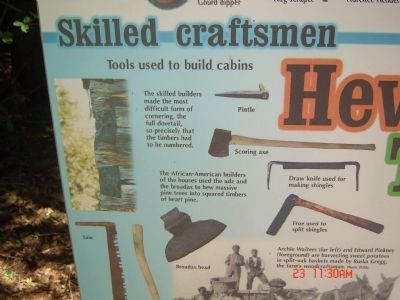
Photographed By Michael Sean Nix, April 23, 2009
17. Hewn-Timber Cabins Information Sign
Tools used to build cabins include pintle, scoring axe, draw knife, froe, broad axe, wedge, maul and saw. Captions include: "The skilled builders made the most difficult form of cornering, the full dovetail, so precisely that the timbers had to be numbered." and "The African-American builders of the houses used the adz and the broadax to hew massive pine trees into squared timbers of heart pine."
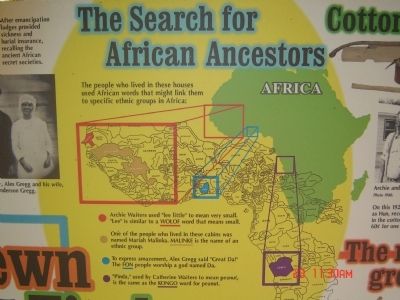
Photographed By Michael Sean Nix, April 23, 2009
20. Hewn-Timber Cabins Information Sign
The Search for African Ancestors
The people who lived in these houses used African words that might link them to specific ethnic groups in Africa:
Archie Waiters used "lee little" to mean very small. "Lee" is similar to a WOLOF word that means small.
One of the people who lived in these cabins was named Mariah Malinka. Malinke is the name of an ethnic group.
To express amazement, Alex Gregg said "Great Da!" The FON people worship a god named Da.
"Pinda," used by Catherine Waiters to mean peanut, is the same as the KONGO word for peanut.
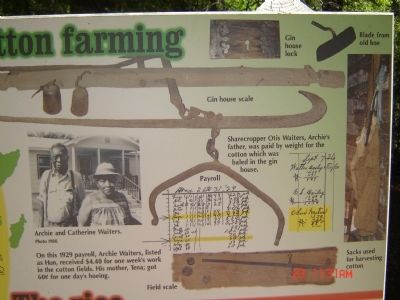
Photographed By Michael Sean Nix, April 23, 2009
21. Hewn-Timber Cabins Information Sign
Cotton Farming
This section includes photos of gin house lock, blade of old hoe, gin house scale, sacks used for harvesting, field scale, photo of Archie and Catherine Waiters, and a payroll.
Archie's father Otis was paid by the weight of the cotton baled in the gin house.
In 1929, Archie Waiters, listed as Hun on the payroll, received $4.40 for one week's work in the cotton fields. His mother, Tena; got 60 cent for one days hoeing.
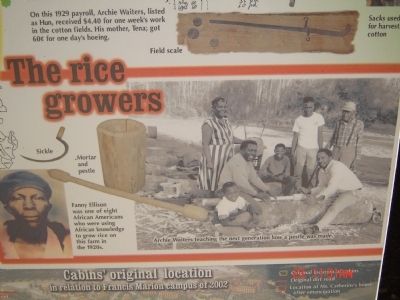
Photographed By Michael Sean Nix, April 23, 2009
22. Hewn-Timber Cabins Information Sign
The Rice Growers
Photos show a sickle, mortar, and pestle. Also, a photo of Fanny Ellison (one of eight African-Americans using African knowledge to grow rice on the farm in the 1920s)and Archie Waiters showing how a pestle was made.
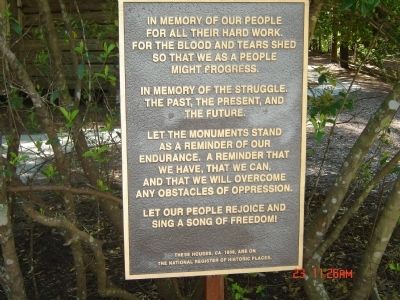
Photographed By Michael Sean Nix, April 23, 2009
23. Memorial marker
In memory of our people for all their hard work; for the blood and tears shed so that we as a people might progress. In memory of the struggle; the past, the present, and the future. Let the monuments stand as a reminder of our endurance; a reminder that we have, that we can, and that we will overcome any obstacles of oppression. Let our people rejoice and sing a song of freedom! (These houses, ca. 1836, are on the National Register of Historic Places.)
Credits. This page was last revised on June 16, 2016. It was originally submitted on April 23, 2009, by Michael Sean Nix of Spartanburg, South Carolina. This page has been viewed 2,109 times since then and 60 times this year. Photos: 1, 2, 3, 4, 5, 6, 7, 8, 9, 10, 11, 12, 13, 14, 15, 16, 17, 18, 19, 20, 21, 22, 23. submitted on April 23, 2009, by Michael Sean Nix of Spartanburg, South Carolina. • Christopher Busta-Peck was the editor who published this page.
